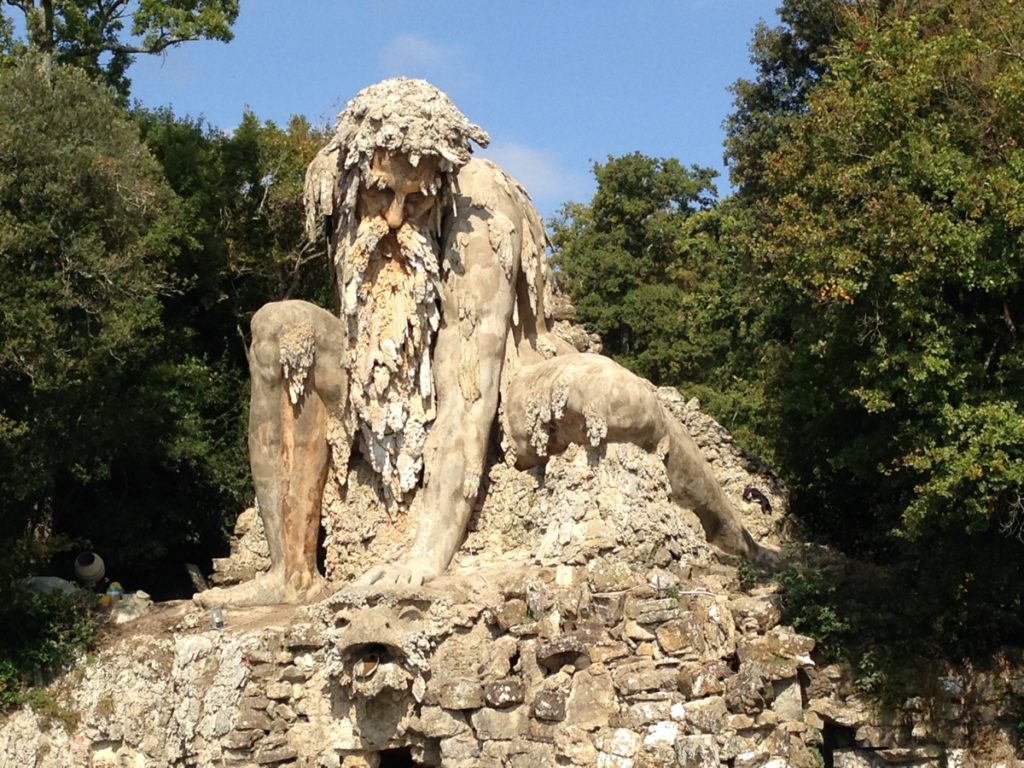
Until Oct. 31: VISITS TO THE ‘GIANT OF THE APENNINES’ & THE PRATOLINO PARK. Pratolino, accessible via public transportation: bus 25 or the SITA from Florence’s train station. Free admission. Open Friday 10 am – 5 pm, Saturday and Sunday 10 am –7 pm through the end of the month. The park will reopen again in April.
A monumental sculpture, the chief attraction in a park commissioned for a princess, is once again visible to the public after restoration. Finally free of scaffolding, the sixteenth century “Gigante dell’Appeninno” (The Giant of the Apennines) was sculpted by Giambologna for the new home of Tuscany’s rulers, Francesco I de’ Medici and his second wife and longtime mistress, Bianca Cappello, at Pratolino.
A Venetian beauty, Bianca Cappello was disliked by the Florentines so much so that Francesco decided to bypass the numerous existing Medici villas to build a new country estate at Pratolino, between 1569 and 1591. The 40 ft. “Giant” was the focal point of a new Medici country home amid a great deal of controversy.
After the accidental, sudden death of Francesco’s first wife, Joanna, Archduchess of Austria, in 1578, Francesco married Bianca Cappello at Pratolino in 1579. Located far from Florence yet only five miles north of the city, the newly-acquired property, filled with meadows and surrounded by woods, became the venue for the sumptuous wedding of the noble pair.
The Flemish sculptor Jean de Bologne (1529 – 1608), known in Italy as Giambologna, was entrusted with the transformation of forests and fields into a fairytale setting for the noble couple. Employed by the Medici court, Giambologna had already created sets and decorations as a backdrop for Francesco’s first marriage ceremony. He was to design the sculpture group The Rape of the Sabines in Piazza Signoria’s Loggia dei Lanza as well as the Ocean Fountain in the Boboli Gardens.
An exponent of Mannerist art movement, Giambologna’s “Giant of the Apennines” blurs the line between nature and art. Made of masonry and plaster, the Giant’s massive body is decorated with stonework that imitates stalactites inside a grotto. The sculpture, in fact, originally contained a grotto decorated with frescoes, a fountain, and water jets. Still today it overlooks a pond filled with water lilies.
Giambologna was also responsible for overseeing the landscaping and fountains that were to perpetuate a dreamlike atmosphere of a place that would become known throughout Europe as “The Garden of Wonders.” After Francesco’s and Bianca’s unexpected deaths – of malaria or poison – in 1587, the later Medici rulers added their touch to Pratolino. One, Ferdinando, inaugurated a theatre that would host concerts by Handel and Scarlatti.
The political descendants of the Medici, the Lorraine grand dukes of Tuscany, had the original villa, which was by then structurally unsound, demolished in 1824 and hired Czech landscape architect Joseph Frietsch, who changed the appearance of the garden to conform with the less-structured, more open style of the Romantic era. Sold to the Demidoff family, Pratolino was acquired by the province of Florence at auction in 1981.
Thanks to Francesco de’ Medici’s wish to create a romantic country getaway, Pratolino today is a vast park containing a wide variety of flora and fauna open to all for a visit. While the statues by Cellini, Ammanati and Bandinelli no longer grace what is now a historic nature preserve, an impressive echo from distant past remains, as solid as the nearby mountain range for which it is named: The Giant of the Apennines. (rosanna cirigliano)








